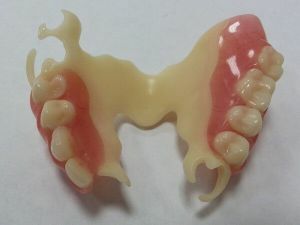 The development of polymeric materials and new technologies in dentistry and prosthetics led to the appearance of acetal prostheses.
The development of polymeric materials and new technologies in dentistry and prosthetics led to the appearance of acetal prostheses.
Among the main advantages of this type of prosthetics can be called a good adaptation of products in the oral cavity, almost complete absence of allergic reactions and ease of construction.
Acetalate is a polymer resin that consists of structured chains, hydrogen, oxygen and carbon elements. The chemical composition does not include any additional impurities. The material has other names: polyformaldehyde, polyoxymethylen, polivacetal.
Contents
- Advantages and disadvantages of the structure of acetalate
- Clasp structure
- Design features
- Manufacturing and installation
- Care features
- Selection of interesting opinions
- About the cost of
Advantages and disadvantages of the construction of acetalate
A number of advantages of prostheses made of synthetic polymeric resins significantly covers their disadvantages.
Advantages include:
- Supporting clasps and locks are also made of polymer, which excludes the use of metal. This makes the products less noticeable.
- For strength polyacetal is equated to metal. Therefore, the prosthesis has good wear resistance.
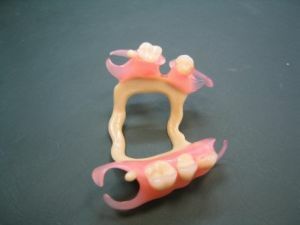
- Polymer resin is a more ductile material. Due to these properties, it most accurately repeats the reliefs of the sky and jaw, thus ensuring a good fit and fixation.
- In clasp prostheses, not all the sky is closed, only a part. This reduces the level of discomfort, which in turn contributes to early addiction.
- The products have a fairly wide range of shades of artificial teeth, about twenty. In the arsenal of prosthetics there are polymeric compositions that can be used to simulate capillary veins of gums.
- Polymer resins are resistant to aggressive environment in the oral cavity, acids, alkalis, dyes, which fall from the human diet.
- It is quite easy for a doctor to adjust a prosthesis, as it is easy to process.
- One-piece construction has good fixation.

Among the shortcomings is worth noting:
- Over time, the acetal denture changes its hue, as the polymer structure has micropores. Proper care can significantly reduce the effect of color change.
- With a strong bite or incorrect installation, a feeling of mobility of the teeth may occur. For this reason, such products are not recommended for stitches during loosening of teeth.
- When the reduction of gingival bone tissue occurs and a gap is formed, it is difficult to adjust the parameters of the prosthesis. Acetal products reduce the load on the gum, so there is a threat of such a defect.
Those who previously wore plastic prostheses with metal fastenings note that acetal is much lighter and thinner.
We use polymeric prosthetics to replace individual teeth or their groups. Polymer resins are used for temporary prosthetics, making them crowns.
This material was widely used in the production of clasp systems.
Clasp structure
Clasp prosthesis made of acetal is a single cast system.
It consists of:
- of arc-shaped structure;
- of the relief jaw arc and row, which form the basis for fixing the teeth;
- fasteners( clamps, attachments), through which the system is fixed.
Design features
The advantage of this solution is that in this case, almost no need to grind healthy teeth for locks of fasteners. This distinguishes plastic prosthesis from acetal.
Elastic, but sturdy clasps of polyformaldehyde, much less injure the gum tissue.
If a more stable fixation system is required, then use in combination with metal is possible. The acetal insert, in this case, is used as an attachment.
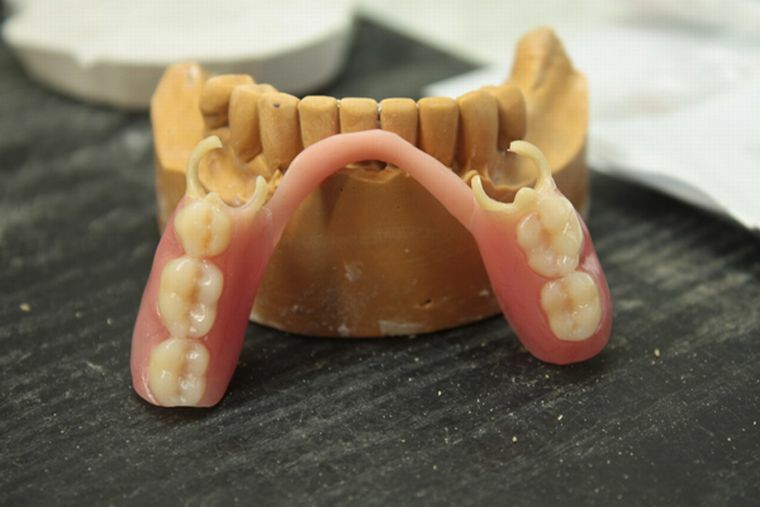
On the photo acetal clasp prosthesis
Manufacture and installation
First the doctor conducts inspection and sanitation of the oral cavity. Then determines the design of the future prosthesis.
When everything is ready, make a mold. Even if prosthetics is performed on one of the jaws, the impression is made from two, in order to correctly correct the occlusion and take into account the anatomical features of the structure. Then reprints are made from special silicones.
Stages of manufacture:
- in the laboratory conditions from the casts produce a plaster model of the jaw;
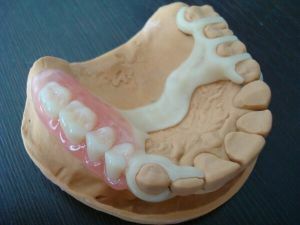
- they are put on wax cushions;The
- model with pinch rollers is sent to the doctor to determine the individual characteristics of the patient's occlusion and to try on the initial version of the prosthesis;
- model of the jaw with impressions direct to technicians in the laboratory;
- after the fitting is made basis;
- then fix teeth in it;
- do a re-fitting, denote inaccuracies;
- further using the technological chain cast prostheses from polyacetal;
- the doctor installs the prosthesis.
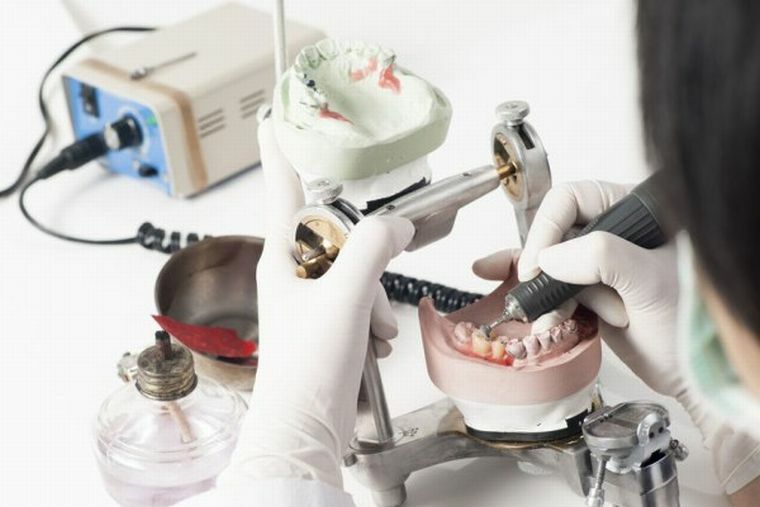
For the installation of prostheses, standard techniques are used. They are attached to healthy teeth, if this is not possible, artificial support bridges are created.
Features of care
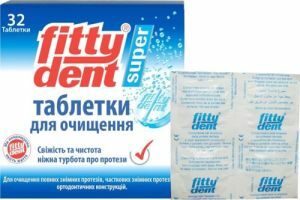 Prostheses from this material can be used without removing, for 2-3 days. In the morning and in the evening brush your teeth using non-abrasive toothpastes.
Prostheses from this material can be used without removing, for 2-3 days. In the morning and in the evening brush your teeth using non-abrasive toothpastes.
Special tablets with bioformula help to rid the prosthesis of bacterial plaque. A removable system is placed in a solution with water for a certain time, after which it is cleaned with a toothbrush.
Ultrasonic cleaning in the dental office will also help to significantly improve the appearance of the structure.
Finding interesting opinions
Only real feedback from people who have something to say about acetal dentures.
The letter came to one of the dental clinics of St. Petersburg:
My husband and I like active leisure. Last summer, together with friends went to Altai, rafted on kayaks along the river. Once the boat overturned, I received a minor injury. Later it was found out that a blow to the jaw led to the formation of a cyst on the nerve of the tooth.
After depulpation, the five became dark with time and began to deteriorate. I installed a polymer temporary crown. I have already been with her for the fifth year. Mounts are not visible at all, and there is no discomfort.
Karina
From Saratov write to the website of the dental clinic:
My mother on the upper jaw was a removable plastic prosthesis. She got used to it for a long time, but still he cut the gum a little. Then he began to lie down badly. The doctor explained that "the gum has sat down."
Recommended a new system of polyacetalate. She went a little more expensive, but my mother is very happy. Do not rub the gum, teeth look almost like their own, my mother began to smile more often.
Toma, 30
A message came from Murmansk to one of the clinics, pensioner writes:
I'm 67 years old, and in the upper row there are no more teeth. I wanted to put an implant, but it did not work out. The doctor advised prostheses on polymers.
After I was tormented with the pins, the installation of this removable system was easy, I quickly got used to them. In appearance they are not worse than cermets. I even put a doctor on the reproach, why he did not recommend them to me before.
Valentina Petrovna, 67
Prostheses based on polymeric mixtures were highly appreciated not only by patients, but also by practicing doctors. Prosthetists note that with all the 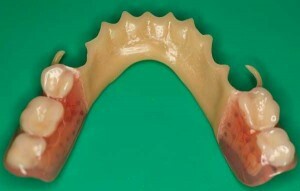 , the complexity of manufacturing polyacetal prostheses justifies their higher cost in comparison with plastic systems.
, the complexity of manufacturing polyacetal prostheses justifies their higher cost in comparison with plastic systems.
Patients are more easily accustomed to them. If the polymer structures are installed after the plastic clasp systems have stood, and shrinkage of the gingival bone tissue has occurred, they last long enough.
Gentle attachment mechanisms allow you to avoid injuring healthy teeth, thereby saving them.
In case of loss of a single tooth, the polyformaldehyde prosthesis can be a temporary but very effective form of prosthetics.
Professionals note that there are restrictions on the installation of acetal prostheses, which are worth remembering, these are:
- loosened teeth;
- with complete loss of teeth, or when there is no fixing base to anchor the system;
- when brackets are installed;
- with a pronounced malocclusion.
To get used to the prosthesis made of polymer, several rules must be observed. Avoid in the first weeks of rough food. Try to eat small portions and chew slowly. A few days do not remove the system at night.
About the cost of
The price of products made of polymer materials is higher than plastic systems, but much lower, for example, cermets.
On average, the clasp system of acetalate costs from 25,000 to 35,000 rubles. The manufacturing process is rather complicated, careful fitting and fitting of the system is required.
Acetal prostheses are very popular among clinic clients, and they were evaluated by practicing doctors.
